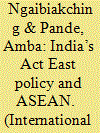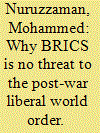|
|
|
Sort Order |
|
|
|
Items / Page
|
|
|
|
|
|
|
| Srl | Item |
| 1 |
ID:
170654


|
|
|
|
|
| Summary/Abstract |
Over the past few decades, India’s security concerns have undergone a substantial change. With the formulation of the Look East Policy (LEP) in the 1990s, the Association of Southeast Asian Nations (ASEAN) as a regional entity became an essential component and a corridor for India’s outreach to Southeast Asia. In 2014, the LEP became more encompassing with a shift to the Act East Policy (AEP). The global security and economic environment too are witnessing significant changes with the USA taking a back seat, China’s aggressive positioning and the Belt and Road Initiative (BRI) coupled with the emerging geopolitical construct of ‘Indo-Pacific’. The regional stakeholders, such as ASEAN, the USA, Japan, Australia and India are yet to form a unified stand on the Indo-Pacific concept as well as the regional security architecture. The AEP appropriately fits into the current scenario as India is set to take up a larger role in the regional security environment while keeping the centrality of ASEAN intact. New Delhi seeks to create a platform for mutual development in the Indo-Pacific and engage with like-minded nations in the quest for a rules-based order that promotes transparency, respect for sovereignty and international law, stability and free and fair-trade framework. India and ASEAN can be apt partners in the Indo-Pacific to play a constructive role and build a regional order.
|
|
|
|
|
|
|
|
|
|
|
|
|
|
|
|
| 2 |
ID:
170650


|
|
|
|
|
| Summary/Abstract |
The notion of semiperiphery refers to specific, delimited, observable and geographically referenced spaces: the semiperipheries fulfil a complex structural function and are not common in the world system. In this way, what countries have transited through these ascending/descending mobilities and now make up the semiperiphery? This article not only presents an extensive theoretical review of the concept of semiperiphery but also demonstrates the coexistence of two groups of states in the semiperiphery: the first, the high or strong, semiperiphery, is composed of the so-called regional powers; the second, the low or weak, semiperiphery, is made up of a group that has been little studied so far and that can be named as secondary regional states. Due to an increase in their material and immaterial capacities, the regional powers entered into a dynamic of rise in the first decade of the twenty-first century and, with this, they strengthened their position in the international structure; secondary regional states did not stand out due to their emergence, but they significantly increased their semi-material capacities, which places them on the path of development. However, none of the cases have overcome their situation and semiperipheral nature.
|
|
|
|
|
|
|
|
|
|
|
|
|
|
|
|
| 3 |
ID:
170649


|
|
|
|
|
| Summary/Abstract |
The Central and East European (CEE) region is often overlooked in the conversations on contemporary geopolitics. Yet, owing to China’s growing relations in
the CEE countries, the region has been subject to increasing international attention. By process tracing the development of the ‘17 + 1’ mechanism, this article
offers a brief overview of Sino-CEE relations. Situated within the broader Belt
and Road Initiative (BRI), the ‘17 + 1’ has provided a unique regional arrangement for extending Chinese influence in the CEE countries. This article explores
whether there is something else than the instrumental economic reasoning for
the willingness of CEE countries to partner with China. The analysis detects
three distinct (and not always complementary) strategic narratives, motivating
the participation of CEE states in the ‘17 + 1’ mechanism. The study concludes
with an enquiry on China’s preparedness to respond to such identity geopolitics
not only in the CEE region but also throughout the vast expanse covered by the
BRI initiative.
|
|
|
|
|
|
|
|
|
|
|
|
|
|
|
|
| 4 |
ID:
170653


|
|
|
|
|
| Summary/Abstract |
BRICS (Brazil, Russia, India, China and South Africa) has emerged as a powerful economic group in the global economy and politics, apparently posing threats to the survival of the post-war liberal world order. Its member states (Brazil, Russia, India, China and South Africa) are seeking to democratize the post-war liberal world order to increase their shares of voting power in the decision-making processes of the Bretton Woods institutions and thus curb the USA’s dominance over global economic and financial architecture and eventually overhaul the US-led liberal world order. Contrary to the fear of many Western policymakers and analysts, this article contends that BRICS poses no credible threats to the US-led post-war order. The BRICS group’s potential to challenge or threaten the US-led world order is seriously undermined by the internal make-up of the group, its political and ideological heterogeneity, its incapacity to develop a collective world order vision salable to the wider international community and the lack of strong convergence in foreign policy goals and preferences.
|
|
|
|
|
|
|
|
|
|
|
|
|
|
|
|
|
|
|
|
|